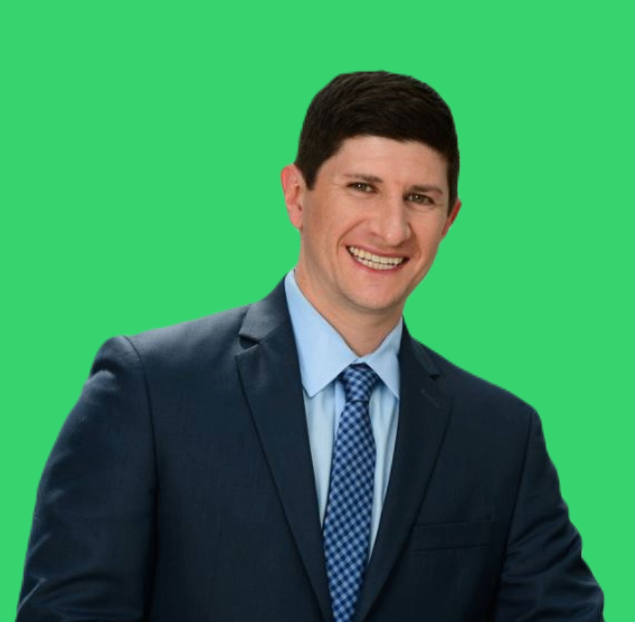Introduction
Navigating the complexities of student loans can be overwhelming, especially for early-career physicians who are just starting to tackle their financial responsibilities.
With so many repayment options and changes in regulations, it’s important to stay informed about the best strategies for your unique situation.
In this blog post, we’ll discuss the current landscape of student loan repayment plans and help you determine whether switching from the Saving on a Valuable Education (SAVE) plan to Income-Based Repayment (IBR) is the right move for you.
Introduction
Navigating the complexities of student loans can be overwhelming, especially for early-career physicians who are just starting to tackle their financial responsibilities.
With so many repayment options and changes in regulations, it’s important to stay informed about the best strategies for your unique situation.
In this blog post, we’ll discuss the current landscape of student loan repayment plans and help you determine whether switching from the Saving on a Valuable Education (SAVE) plan to Income-Based Repayment (IBR) is the right move for you.
🚨December 2024 Update
Wow, this post has been getting a lot of attention lately, thanks for stopping by! As with everything student loans, there’s been an update (surprise, surprise).
On December 18, 2024, the Department of Education announced some big news: two “old” repayment plans are making a comeback!
Starting December 15, 2024, both Pay As You Earn (PAYE) and Income-Contingent Repayment (ICR) are back:
-
PAYE is great for newer borrowers who are not eligible for New IBR and want lower monthly payments.
-
ICR is now an option for folks who no longer qualify for a partial financial hardship but still want a PSLF-eligible plan.
If you’ve been feeling stuck in “SAVE Limbo”, these changes might open up new options for you.
👉 Check out my updated blog post: Stuck in “SAVE Limbo”? Here’s What to Do Next
🚨December 2024 Update
Wow, this post has been getting a lot of attention lately, thanks for stopping by! As with everything student loans, there’s been an update (surprise, surprise).
On December 18, 2024, the Department of Education announced some big news: two “old” repayment plans are making a comeback!
Starting December 15, 2024, both Pay As You Earn (PAYE) and Income-Contingent Repayment (ICR) are back:
-
PAYE is great for newer borrowers who are not eligible for New IBR and want lower monthly payments.
-
ICR is now an option for folks who no longer qualify for a partial financial hardship but still want a PSLF-eligible plan.
If you’ve been feeling stuck in “SAVE Limbo”, these changes might open up new options for you.
👉 Check out my updated blog post: Stuck in “SAVE Limbo”? Here’s What to Do Next
Subscribe to The Dream Bigger – Physician Edition Newsetter
A weekly newsletter designed for early-career physicians and anyone looking to enhance their financial well-being.
Discover helpful tips, strategies, and insights to dream bigger and take control of your financial future. 🥼
Get student loan updates, money-saving tips, and financial strategies – all delivered to your inbox.
Subscribe to The Dream Bigger – Physician Edition Newsetter
A weekly newsletter designed for early-career physicians and anyone looking to enhance their financial well-being.
Discover helpful tips, strategies, and insights to dream bigger and take control of your financial future. 🥼
Get student loan updates, money-saving tips, and financial strategies – all delivered to your inbox.
Current Student Loan Situation (As of October 2024)
In July 2024, a court order blocked the implementation of the SAVE IDR plan, causing widespread disruptions in the student loan repayment process. As of September 30, 2024:
👎 The SAVE IDR plan is currently BLOCKED!
👍 Enrolling or switching Income-Driven Repayment (IDR) plans is AVAILABLE!
👍 Student Loan Consolidation is AVAILABLE!
👍 Applying for Public Service Loan Forgiveness (PSLF) is AVAILABLE! However, expect significant delays…
Please note: While you can submit your application, there is currently no confirmation on whether loan servicers are processing IDR applications. Updates may be available soon. This means even if you want to, you can not currently switch IDR plans.
Current Student Loan Situation (As of October 2024)
In July 2024, a court order blocked the implementation of the SAVE IDR plan, causing widespread disruptions in the student loan repayment process. As of September 30, 2024:
👎 The SAVE IDR plan is currently BLOCKED!
👍 Enrolling or switching Income-Driven Repayment (IDR) plans is AVAILABLE!
👍 Student Loan Consolidation is AVAILABLE!
👍 Applying for Public Service Loan Forgiveness (PSLF) is AVAILABLE! However, expect significant delays…
Please note: While you can submit your application, there is currently no confirmation on whether loan servicers are processing IDR applications. Updates may be available soon. This means even if you want to, you can not currently switch IDR plans.
The Issue
Currently, there are four Income-Driven Repayment (IDR) Plans eligible for Public Service Loan Forgiveness (PSLF):
-
-
Saving on a Valuable Education (SAVE)
-
Pay As You Earn (PAYE)
-
Income-Based Repayment (IBR)
-
Income-Contingent Repayment (ICR)
-
Note: PAYE is not accepting new enrollments, and ICR is available only under specific circumstances. This leaves SAVE and IBR as the eligible IDR plans for PSLF.
Recently, the Department of Education announced that time under the SAVE plan does not count towards PSLF qualification. Because of this, many are now considering whether they should switch to IBR.
The Issue
Currently, there are four Income-Driven Repayment (IDR) Plans eligible for Public Service Loan Forgiveness (PSLF):
-
Saving on a Valuable Education (SAVE)
-
Pay As You Earn (PAYE)
-
Income-Based Repayment (IBR)
-
Income-Contingent Repayment (ICR)
Note: PAYE is not accepting new enrollments, and ICR is available only under specific circumstances. This leaves SAVE and IBR as the eligible IDR plans for PSLF.
Recently, the Department of Education announced that time under the SAVE plan does not count towards PSLF qualification. Because of this, many are now considering whether they should switch to IBR.
Should I Switch to IBR if I’m Currently on SAVE?
Maybe…
If you’re on the SAVE plan, your student loan servicer has likely placed you in interest-free forbearance. During this period, you are not required to make payments, and your loan balance won’t grow. However, this time does not count toward Public Service Loan Forgiveness (PSLF).
If you’re not pursuing PSLF, this could be a positive situation. You avoid payments, your balance stays the same, and you can use those funds for other priorities or save for when repayment resumes.
However, if you’re working towards PSLF, this period could be costly—especially if you’re in training—since you’re losing out on months of qualifying payments.
Should I Switch to IBR if I’m Currently on SAVE?
Maybe…
If you’re on the SAVE plan, your student loan servicer has likely placed you in interest-free forbearance. During this period, you are not required to make payments, and your loan balance won’t grow. However, this time does not count toward Public Service Loan Forgiveness (PSLF).
If you’re not pursuing PSLF, this could be a positive situation. You avoid payments, your balance stays the same, and you can use those funds for other priorities or save for when repayment resumes.
However, if you’re working towards PSLF, this period could be costly—especially if you’re in training—since you’re losing out on months of qualifying payments.
Understanding the Cost of SAVE’s Interest-Free Forbearance
Income-Driven Repayment (IDR) Plans:
When you start your residency (or leave school), you are automatically enrolled in the Standard 10-Year Repayment Plan.
This plan works similarly to a mortgage, calculating your monthly student loan payment based on your loan balance and interest rate.
For example, if your student loan balance is $260,000 with an interest rate of 6%, your monthly payment would be a hefty $2,887!
Enrolling in an IDR plan can dramatically reduce your monthly student loan payments.
Unlike the Standard 10-Year Repayment Plan, which calculates payments based on your loan balance and interest rate, IDR plans base your payment on your income and family size.
-
-
Lower Income = Lower Payments: The lower your income, the smaller your monthly payment will be.
-
Larger Family Size = Lower Payments: A larger family size also reduces your payment.
-
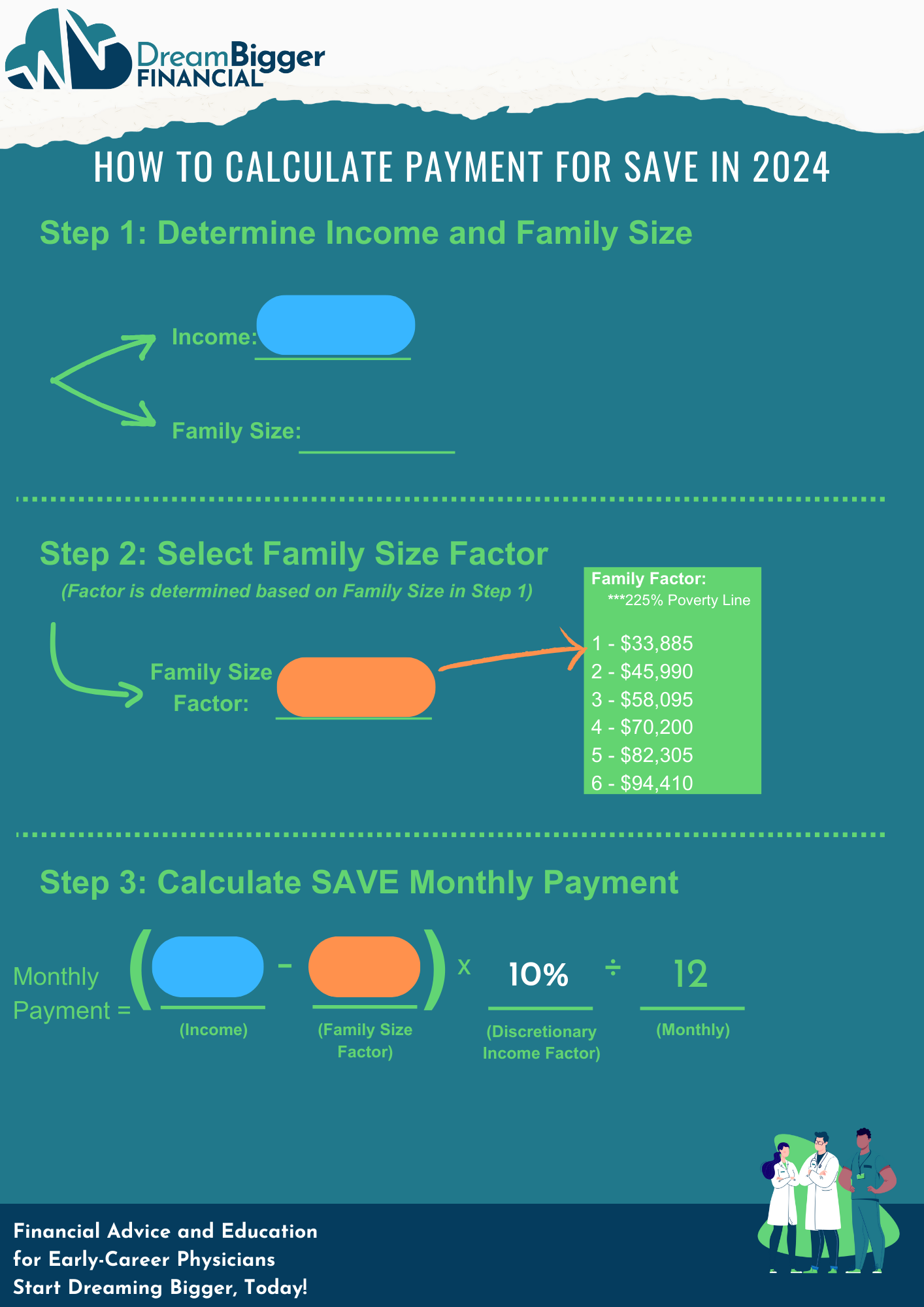
Example: IDR Payment Under The SAVE Plan (Resident)
Note: This strategy would work for other IDR plans, but the calculation would be different.
-
-
Loan Balance: $260,000
-
Resident Income: $60,000
-
Attending Income: $300,000
-
Under PSLF, you need to make 120 qualifying payments, and it doesn’t matter if your income is $60,000 or $300,000 — each payment counts the same.
With a resident salary of $60,000, your monthly payment under the SAVE plan could be as low as $218.
If you could enroll in SAVE today, every $218 payment would count toward your 120 PSLF payments.
You can learn more about PSLF here.
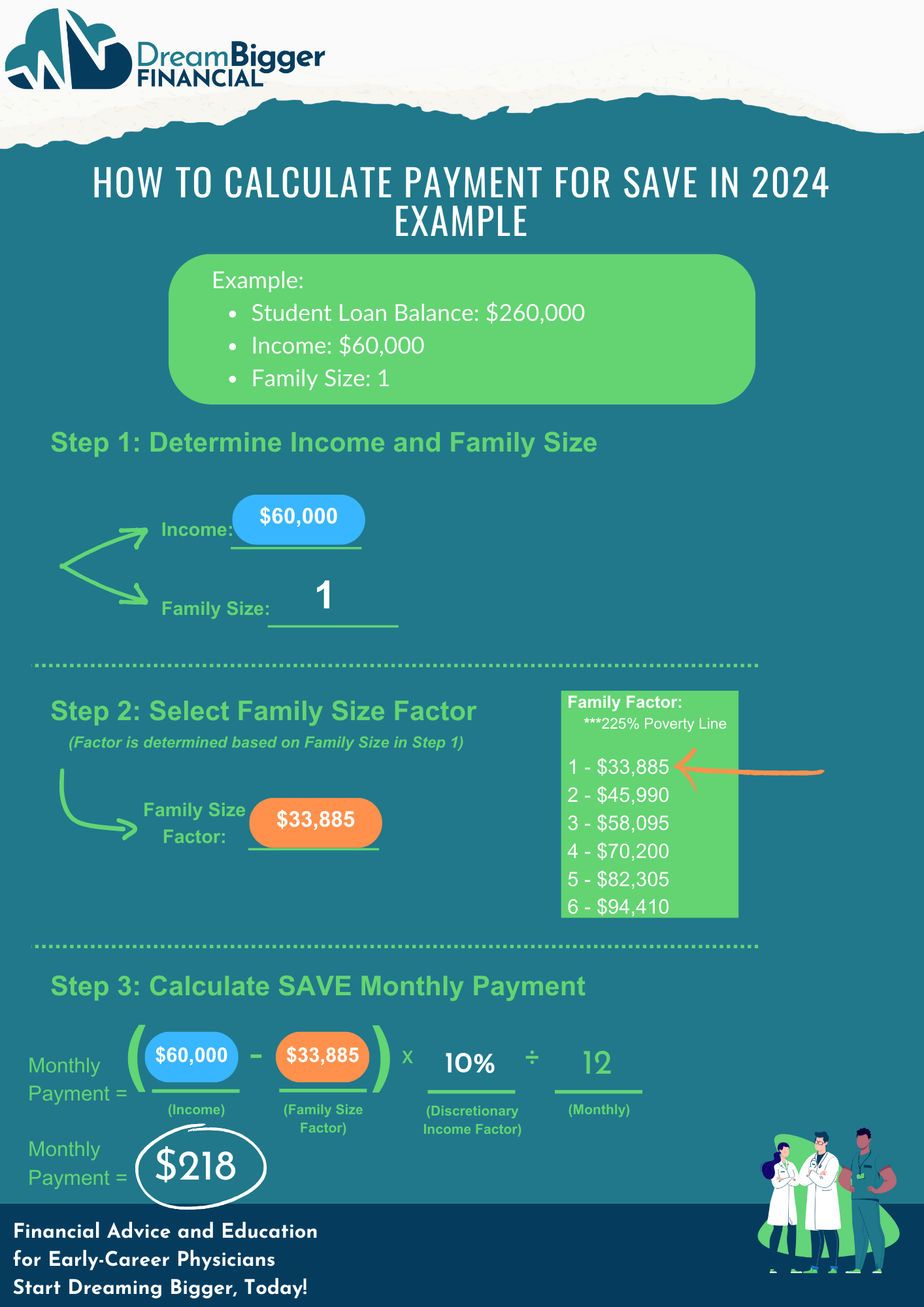
Example: IDR Payment Under The SAVE Plan (Attending)
Now, fast forward to when you’re earning $300,000 as an attending.
At that point, your monthly payment would rise to $2,218.

The Cost of The Department of Education’s Indecisiveness
If you are in interest-free forbearance, this time is not eligible for PSLF. This prevents you from benefiting from low payments based on your resident salary, forcing you to make higher $2,218 attending-level payments in the future.
In our example, this is costing you an extra $2,000 per month. It will cost you even more if SAVE goes away and you need to enroll in a different repayment plan!
If you remain on interest-free forbearance for six months, that’s an additional $12,000 ($2,000 x 6) in loan payments you would have had to make.
-
-
The higher your future income, the greater the financial impact.
-
The longer everything is frozen, the heavier the burden on your finances.
-
Understanding the Cost of SAVE’s Interest-Free Forbearance
Income-Driven Repayment (IDR) Plans:
When you start your residency (or leave school), you are automatically enrolled in the Standard 10-Year Repayment Plan.
This plan works similarly to a mortgage, calculating your monthly student loan payment based on your loan balance and interest rate.
For example, if your student loan balance is $260,000 with an interest rate of 6%, your monthly payment would be a hefty $2,887!
Enrolling in an IDR plan can dramatically reduce your monthly student loan payments.
Unlike the Standard 10-Year Repayment Plan, which calculates payments based on your loan balance and interest rate, IDR plans base your payment on your income and family size.
-
Lower Income = Lower Payments: The lower your income, the smaller your monthly payment will be.
-
Larger Family Size = Lower Payments: A larger family size also reduces your payment.

Example: IDR Payment Under The SAVE Plan (Resident)
Note: This strategy would work for other IDR plans, but the calculation would be different.
-
Loan Balance: $260,000
-
Resident Income: $60,000
-
Attending Income: $300,000
Under PSLF, you need to make 120 qualifying payments, and it doesn’t matter if your income is $60,000 or $300,000 — each payment counts the same.
With a resident salary of $60,000, your monthly payment under the SAVE plan could be as low as $218.
If you could enroll in SAVE today, every $218 payment would count toward your 120 PSLF payments.
You can learn more about PSLF here.

Example: IDR Payment Under The SAVE Plan (Attending)
Now, fast forward to when you’re earning $300,000 as an attending.
At that point, your monthly payment would rise to $2,218.

The Cost of The Department of Education’s Indecisiveness
If you are in interest-free forbearance, this time is not eligible for PSLF. This prevents you from benefiting from low payments based on your resident salary, forcing you to make higher $2,218 attending-level payments in the future.
In our example, this is costing you an extra $2,000 per month. It will cost you even more if SAVE goes away and you need to enroll in a different repayment plan!
If you remain on interest-free forbearance for six months, that’s an additional $12,000 ($2,000 x 6) in loan payments you would have had to make.
-
The higher your future income, the greater the financial impact.
-
The longer everything is frozen, the heavier the burden on your finances.
What is Income-Based Repayment?
Income-Based Repayment (IBR) is an Income-Driven Repayment plan that adjusts your monthly payments based on your income and family size.
IBR is currently the only repayment plan accepting new applicants that qualifies for Public Service Loan Forgiveness (PSLF). However, keep in mind that the payments under IBR are typically higher than those calculated under the SAVE plan.
There are two versions of IBR, depending on when you first took out your student loans:
-
-
New IBR: You pay 10% of your discretionary income for undergraduate and graduate loans, with a repayment term of 20 years. After 20 years, any remaining balance is forgiven, though this forgiveness may be taxable.
-
Old IBR: You pay 15% of your discretionary income, with a repayment term of 25 years. Any remaining balance is forgiven after 25 years, and this may also result in a taxable event.
-
Click here to learn more about Income-Based Repayment.
To be eligible for IBR, you need to demonstrate a Partial Financial Hardship. This is determined by comparing your monthly payment under IBR (using 15% of your discretionary income) to what you’d pay under the Standard 10-Year Repayment plan.
Click here to learn more about Partial Financial Hardship.
What is Income-Based Repayment?
Income-Based Repayment (IBR) is an Income-Driven Repayment plan that adjusts your monthly payments based on your income and family size.
IBR is currently the only repayment plan accepting new applicants that qualifies for Public Service Loan Forgiveness (PSLF). However, keep in mind that the payments under IBR are typically higher than those calculated under the SAVE plan.
There are two versions of IBR, depending on when you first took out your student loans:
-
New IBR: You pay 10% of your discretionary income for undergraduate and graduate loans, with a repayment term of 20 years. After 20 years, any remaining balance is forgiven, though this forgiveness may be taxable.
-
Old IBR: You pay 15% of your discretionary income, with a repayment term of 25 years. Any remaining balance is forgiven after 25 years, and this may also result in a taxable event.
Click here to learn more about Income-Based Repayment.
To be eligible for IBR, you need to demonstrate a Partial Financial Hardship. This is determined by comparing your monthly payment under IBR (using 15% of your discretionary income) to what you’d pay under the Standard 10-Year Repayment plan.
Click here to learn more about Partial Financial Hardship.
New IBR – Calculating Your Monthly Payment
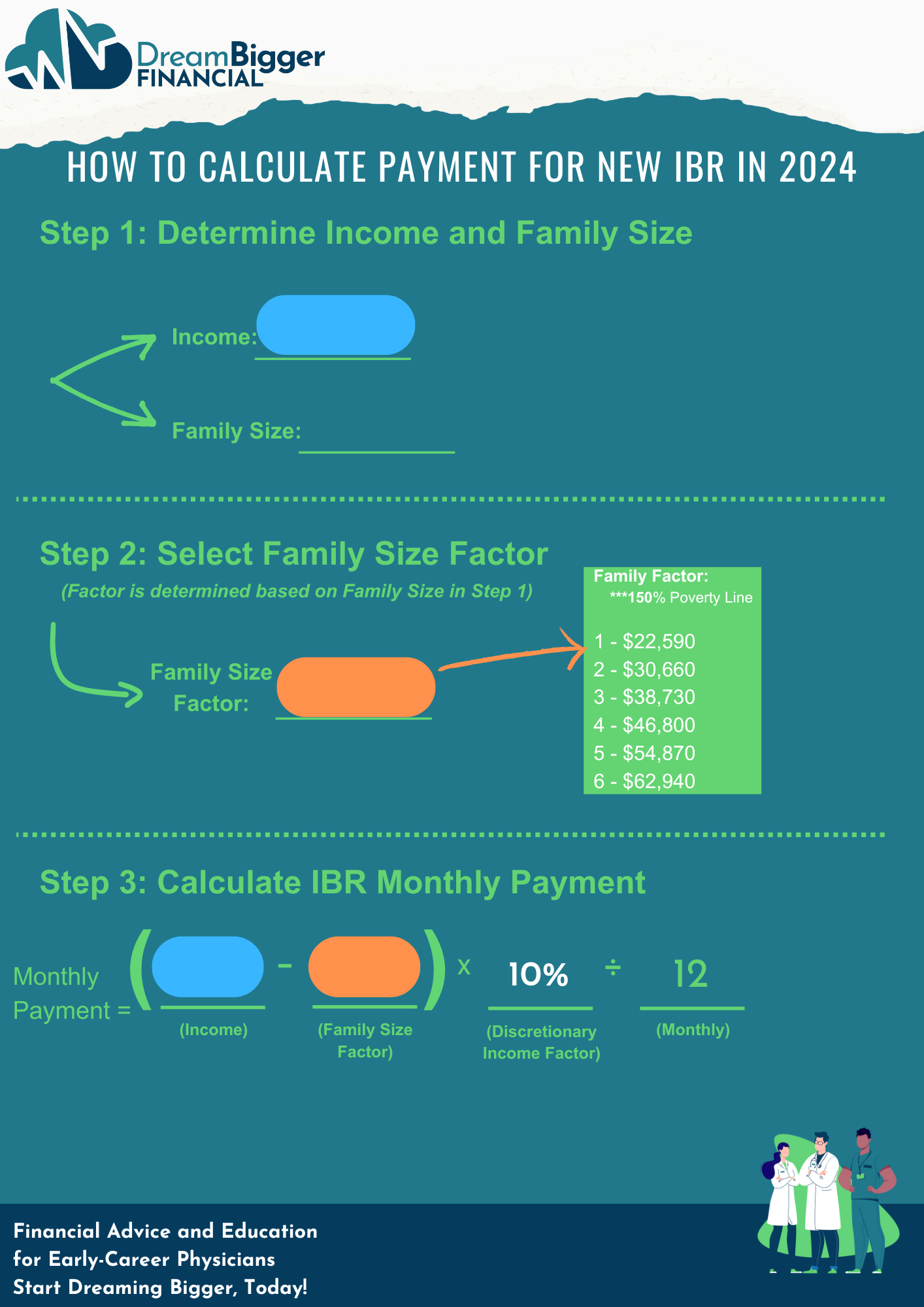
New IBR – Calculating Your Monthly Payment

Old IBR – Calculating Your Monthly Payment
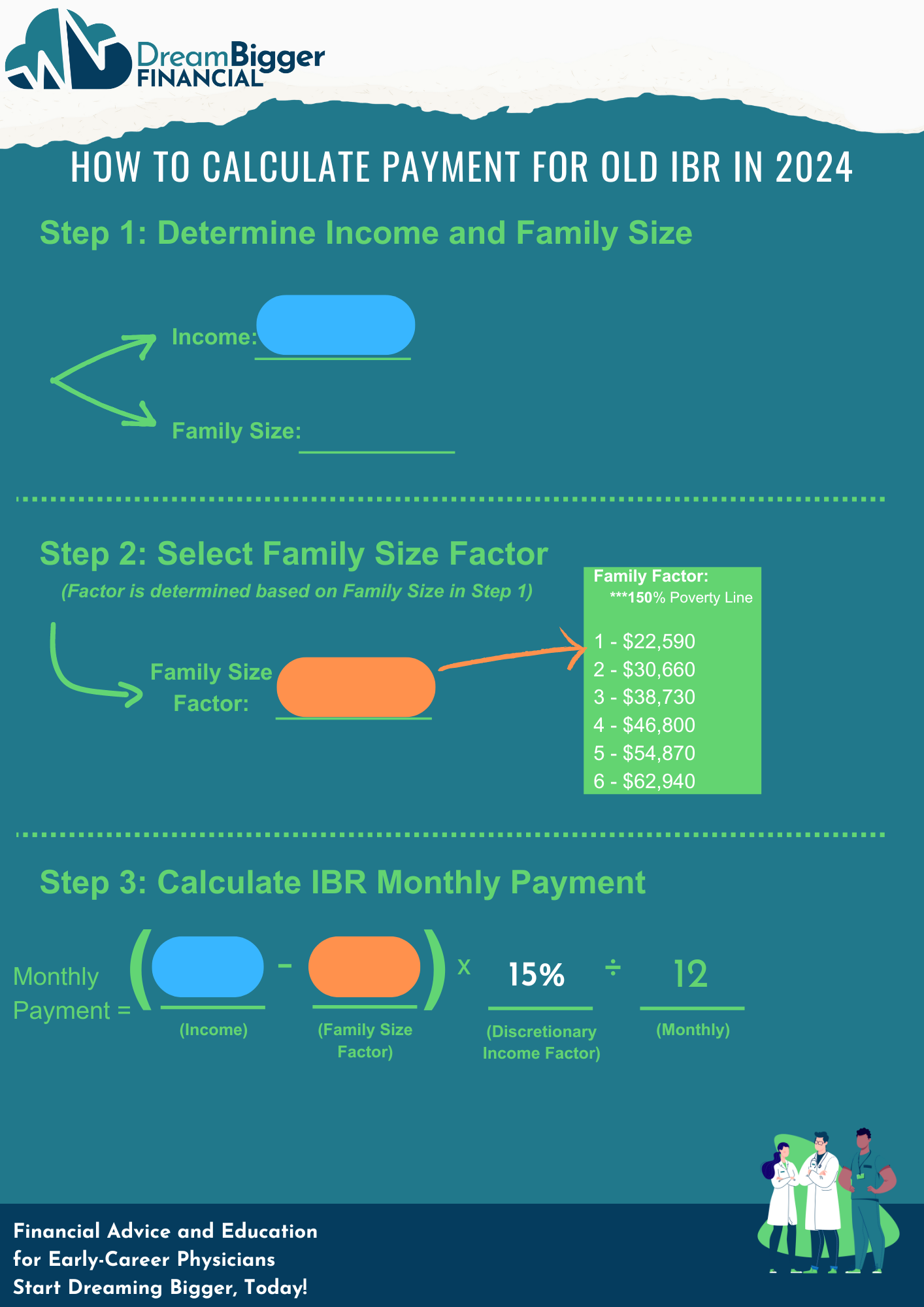
Old IBR – Calculating Your Monthly Payment

What Happens When You Switch Income-Driven Repayment Plans?
When you switch Income-Driven Repayment (IDR) plans, two key things happen:
-
-
Payment Recalculation: Your monthly payment is adjusted based on your most recent income, family size, and the new IDR plan calculation.
-
-
-
Loan Capitalization: Unpaid interest may be added to your loan balance, increasing the total amount owed. However, if you’re pursuing Public Service Loan Forgiveness (PSLF) or are on the SAVE plan (where interest doesn’t accrue), this shouldn’t affect you.
-
What Happens When You Switch Income-Driven Repayment Plans?
When you switch Income-Driven Repayment (IDR) plans, two key things happen:
-
-
Payment Recalculation: Your monthly payment is adjusted based on your most recent income, family size, and the new IDR plan calculation.
-
-
-
Loan Capitalization: Unpaid interest may be added to your loan balance, increasing the total amount owed. However, if you’re pursuing Public Service Loan Forgiveness (PSLF) or are on the SAVE plan (where interest doesn’t accrue), this shouldn’t affect you.
-
Scenario 1: Physician in Training
If you’re currently on the SAVE plan and in training, earning around $60,000, your monthly student loan payment is approximately $218.
-
-
If your loans were disbursed on or after July 1, 2014 and you switch to New IBR, your payment will increase to $312.
-
-
-
If your loans were disbursed before July 1, 2014 and you switch to Old IBR, your payment will jump to $468.
-

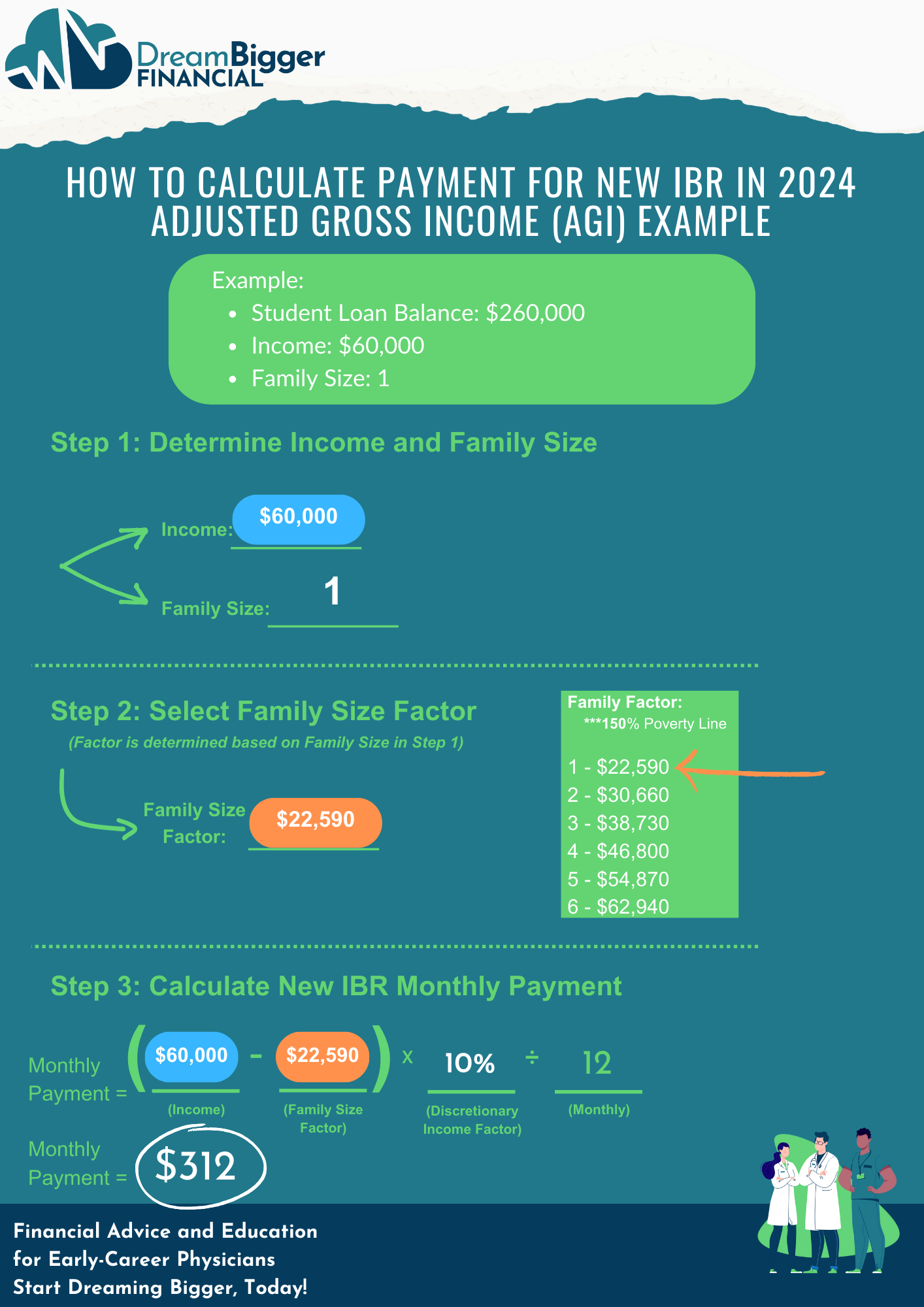
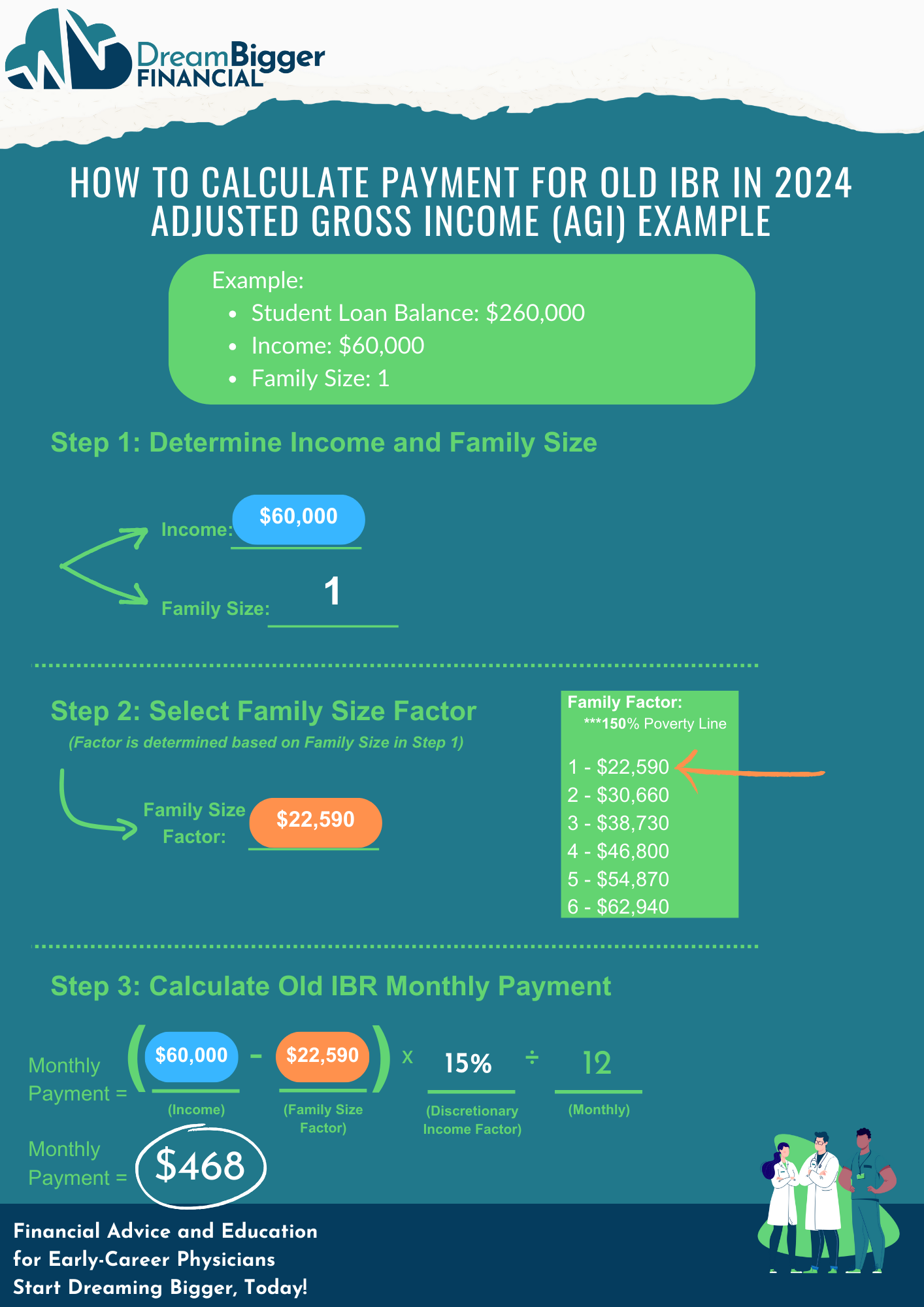
Scenario 1: Physician in Training
If you’re currently on the SAVE plan and in training, earning around $60,000, your monthly student loan payment is approximately $218.
-
If your loans were disbursed on or after July 1, 2014 and you switch to New IBR, your payment will increase to $312.
-
If your loans were disbursed before July 1, 2014 and you switch to Old IBR, your payment will jump to $468.



Scenario 2: Transitioning to Attending with a Higher Income
If you’re currently on the SAVE plan and your payment was last calculated during training—when you were earning around $60,000—your monthly student loan payment is approximately $218. This situation is common for many new attendings, especially if the last time they certified their income was in 2019. Now, as an attending earning $300,000, things change.
-
-
If your loans were disbursed on or after July 1, 2014 and you switch to New IBR, your payment will increase to $2,312.
-
-
-
If your loans were disbursed before July 1, 2014 and you switch to Old IBR, your payment will jump to $2,887. However, you may not be eligible to enroll in Old IBR if you do not have a Partial Financial Hardship.
-
Note: When calculating Old IBR, the estimated monthly payment was $3,468. However, IBR offers a payment cap, where the maximum you pay is equivalent to your Standard 10-Year Repayment. In this example, assuming a 6% interest rate, the maximum monthly payment would be $2,887.

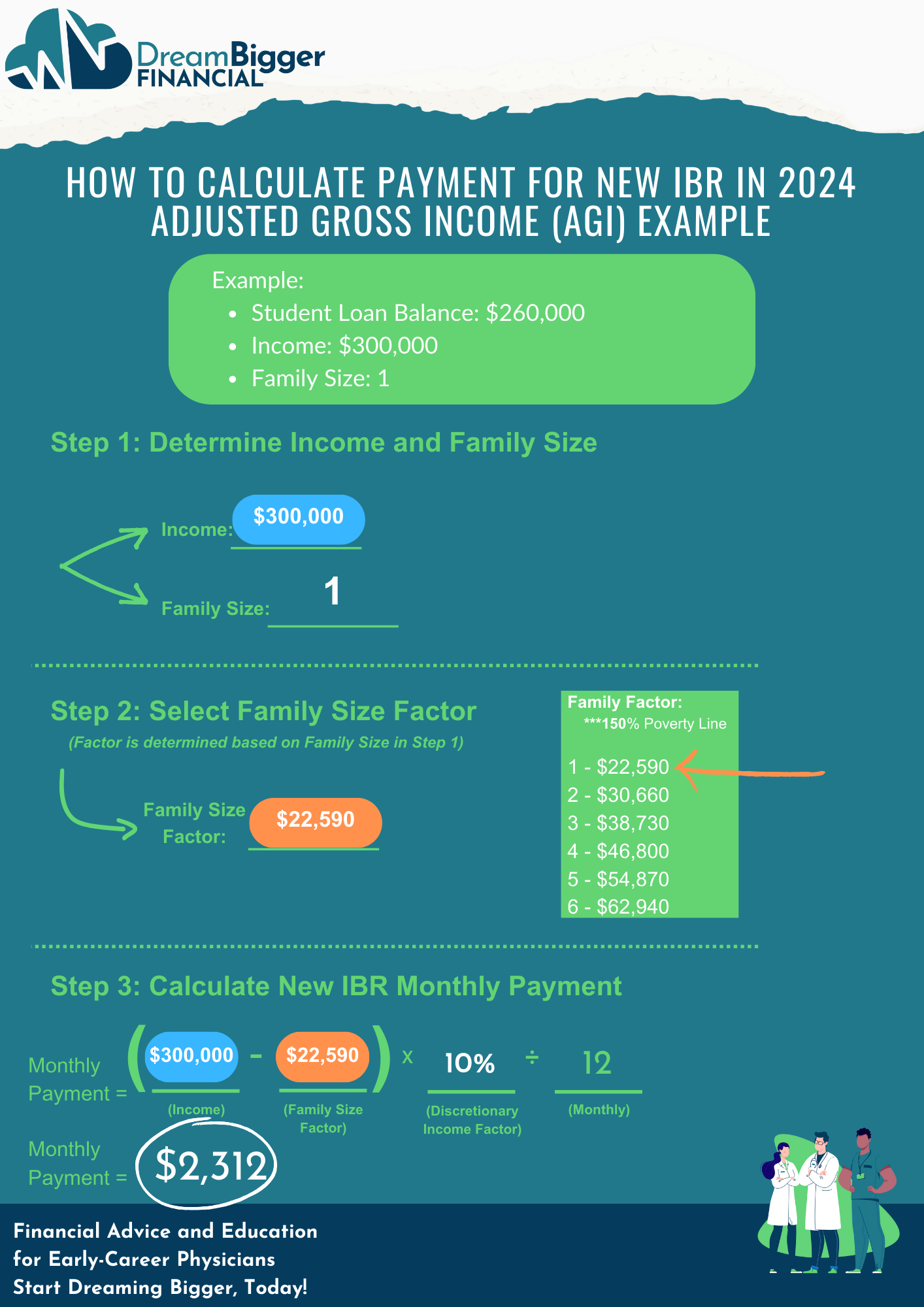
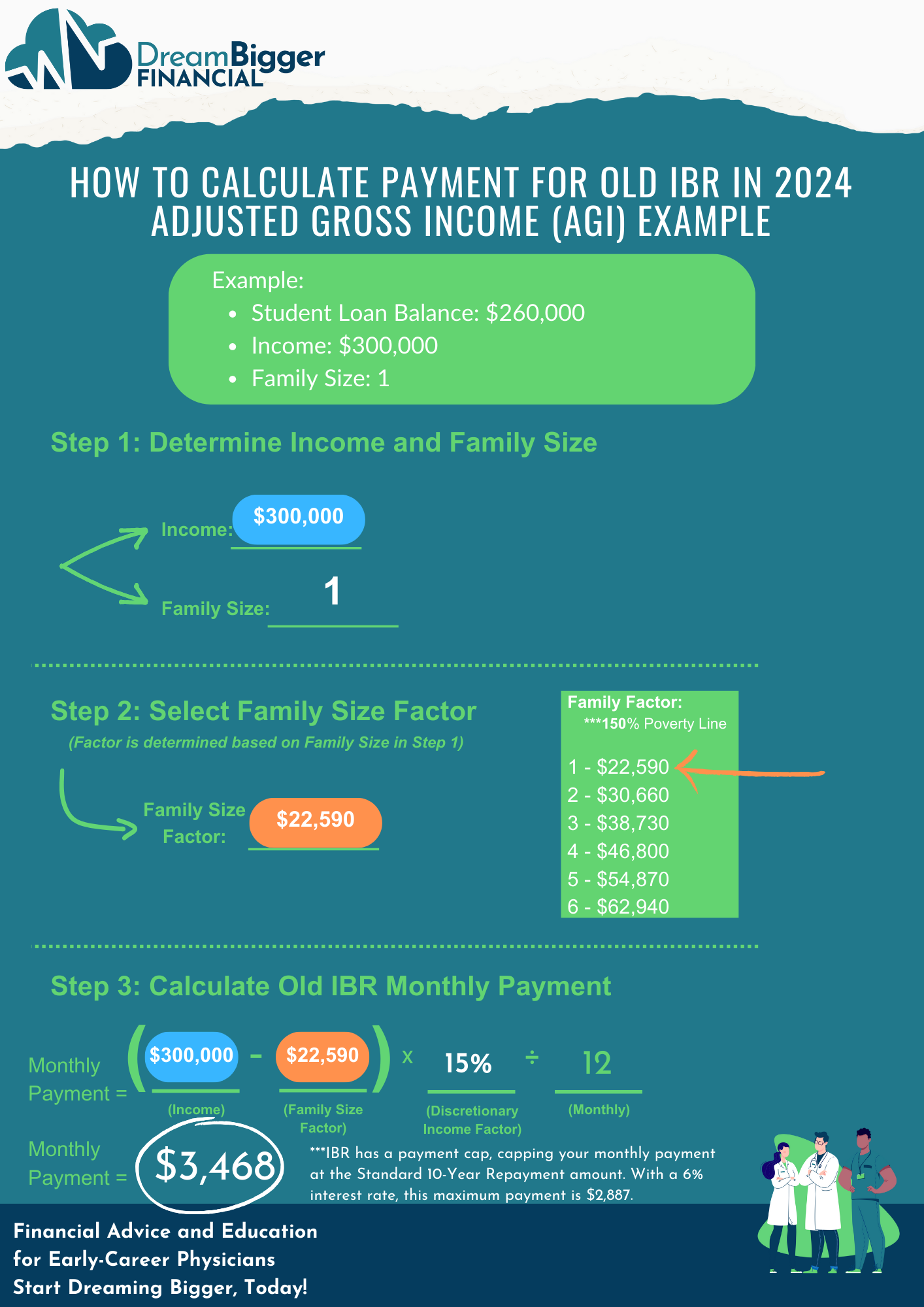
Scenario 2: Transitioning to Attending with a Higher Income
If you’re currently on the SAVE plan and your payment was last calculated during training—when you were earning around $60,000—your monthly student loan payment is approximately $218. This situation is common for many new attendings, especially if the last time they certified their income was in 2019. Now, as an attending earning $300,000, things change.
-
If your loans were disbursed on or after July 1, 2014 and you switch to New IBR, your payment will increase to $2,312.
-
If your loans were disbursed before July 1, 2014 and you switch to Old IBR, your payment will jump to $2,887. However, you may not be eligible to enroll in Old IBR if you do not have a Partial Financial Hardship.
Note: When calculating Old IBR, the estimated monthly payment was $3,468. However, IBR offers a payment cap, where the maximum you pay is equivalent to your Standard 10-Year Repayment. In this example, assuming a 6% interest rate, the maximum monthly payment would be $2,887.



Conclusion
Deciding whether to switch from the SAVE plan to IBR involves carefully weighing your current financial situation against your goals for Public Service Loan Forgiveness. The scenarios discussed here represent just a couple of possibilities among many; each person’s situation is unique.
If you’re still in training or early in your attending position, understanding how these repayment plans affect your monthly payments and long-term financial health is important.
Consider consulting a financial professional specializing in tax management and student loan planning to tailor your repayment strategy to your specific circumstances and objectives. If you’re looking for a personalized plan, our team is here to help!
Disclosure: This content is for informational purposes only and does not constitute personalized financial advice. We recommend consulting with your tax and financial professional for tailored guidance.
Conclusion
Deciding whether to switch from the SAVE plan to IBR involves carefully weighing your current financial situation against your goals for Public Service Loan Forgiveness. The scenarios discussed here represent just a couple of possibilities among many; each person’s situation is unique.
If you’re still in training or early in your attending position, understanding how these repayment plans affect your monthly payments and long-term financial health is important.
Consider consulting a financial professional specializing in tax management and student loan planning to tailor your repayment strategy to your specific circumstances and objectives. If you’re looking for a personalized plan, our team is here to help!
Disclosure: This content is for informational purposes only and does not constitute personalized financial advice. We recommend consulting with your tax and financial professional for tailored guidance.
Start Dreaming Bigger,
Finally Take Control of Your Student Loans!
Start Dreaming Bigger,
Finally Take Control of Your Student Loans!
It All Begins with a Diagnosis…
At Dream Bigger Financial, we’re dedicated to setting early-career physicians on the right financial treatment plan.
With a comprehensive diagnosis, we guide you towards financial peace of mind, ensuring you can be your best self for your loved ones and patients.
Considering financial planning?
We’re currently accepting new patients!
If you prefer self-diagnosing,
join us on social media!
We regularly share tips and tricks on lowering taxes, managing student loans, saving for retirement, and guiding you to live your best financial life.
It All Begins with a Diagnosis…
At Dream Bigger Financial, we’re dedicated to setting early-career physicians on the right financial treatment plan.
With a comprehensive diagnosis, we guide you towards financial peace of mind, ensuring you can be your best self for your loved ones and patients.
Considering financial planning?
We’re currently accepting new patients!
If you prefer self-diagnosing,
join us on social media!
We regularly share tips and tricks on lowering taxes, managing student loans, saving for retirement, and guiding you to live your best financial life.


